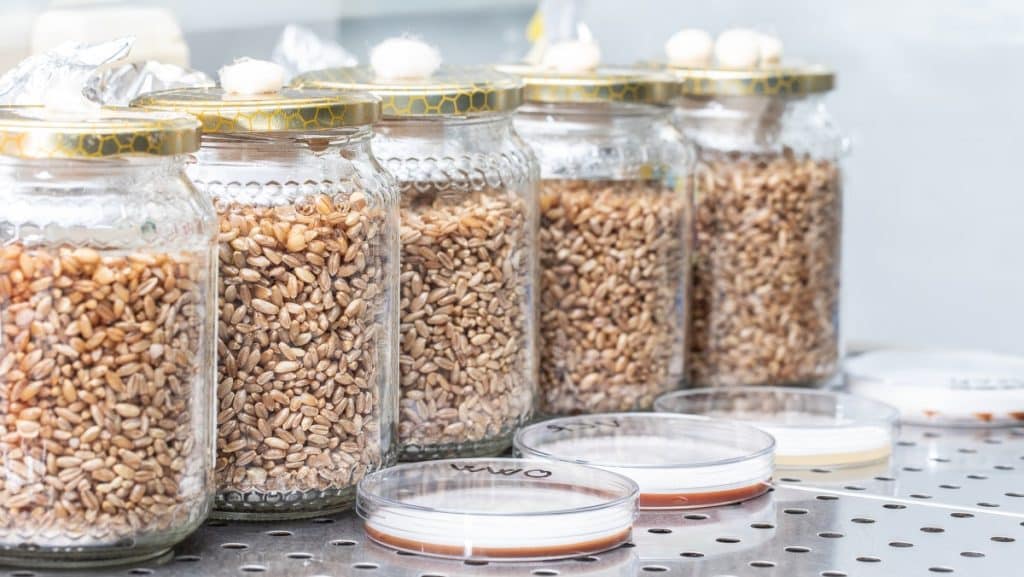The gourmet mushrooms we enjoy for their umami taste and health benefits are the fruiting bodies of fascinating fungi.
Mushrooms only appear briefly but play an important role in the fungi’s life cycle, helping them distribute spores and reproduce.
When the spores land in a spot with decaying organic matter and suitable environmental conditions, they germinate and form new mycelium.
To grow mushrooms year round, mushroom farmers take over the role of introducing mushroom spores or mycelium to suitable organic matter.
Mushroom growing has a lot of industry specific mushroom growing terminology, and cultivators call this process inoculation.
Read on to learn what mushroom inoculation is, the role inoculation plays in the mushroom growing process, how to inoculate and the important factors for success.
What is Inoculation?
Inoculation is the process of adding mushroom spores or spawn to a suitable nutrient medium for growth.
Depending on how and where you’re growing your mushrooms, you may need to inoculate the substrate in sterile conditions to prevent contamination.
There are two inoculation methods:
1. Dry Inoculation
Dry inoculation uses grain, sawdust or plug spawn to introduce mycelium to a mushroom substrate.
Sawdust spawn is commonly used to inoculate larger substrates like mushroom beds or bulk pasteurized straw when growing mushrooms outdoors.
Plug spawn consists of mycelium grown on hardwood dowels designed for insertion into holes drilled into logs.
Grain spawn is most often used when growing mushrooms indoors and used to inoculate straw, sawdust and other substrate mixes.

2. Wet or Liquid Inoculation
Liquid inoculation uses mycelium growing in a nutrient-rich solution or mushroom spores in a sterile solution to inoculate a substrate.
Spore syringes are most often used to inoculate agar plates or grain to grow mushroom mycelium.
Mushroom cultivators generally use liquid culture to inoculate grain to make spawn that is then used to inoculate other growing mediums.
Our article, “Liquid Culture vs. Spore Syringe: Which is Right for You?” has more information on the differences between these liquid inoculation methods to help you choose the the one that best meets your needs.
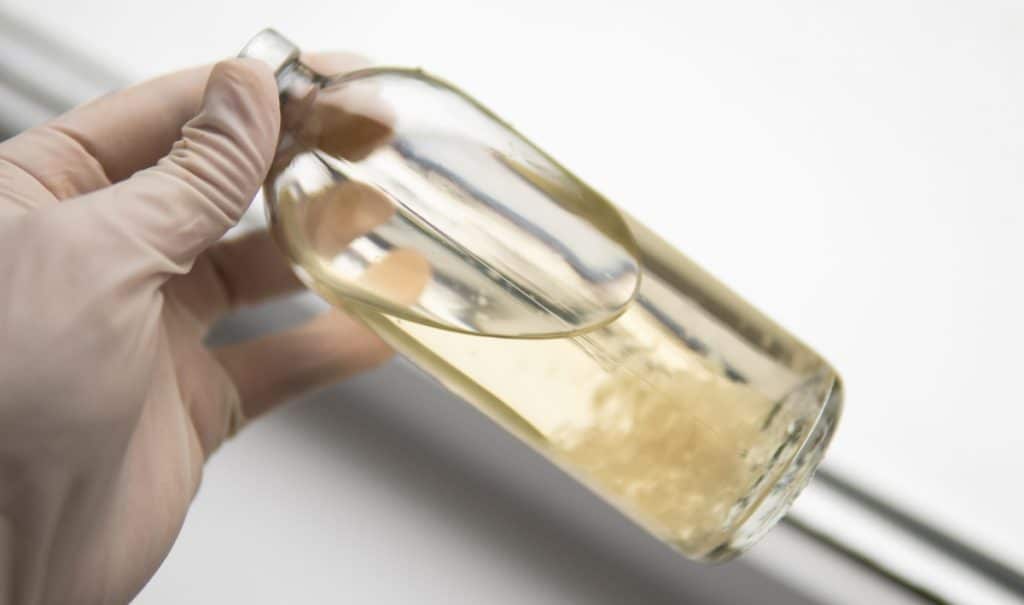
Inoculation and The Mushroom Growing Process
Several stages of mushroom growth involve inoculation.
And even if you plan on buying grain spawn or ready-to-fruit substrate blocks, it helps to understand where inoculation fits in the mushroom-growing process.
Below is a brief overview of the inoculation stages. You’ll find more detail on each of these later in this article.
- The culture stage – In this stage, growers use mushroom tissue or spores to grow mycelium in a nutrient-rich medium. The end result is a petri dish or liquid culture.
- The grain spawn stage – In this stage, growers use the petri dish or liquid culture from the first stage to inoculate sterilized grain to grow more mycelium.
- The sawdust spawn stage – Now, growers can use the grain spawn to inoculate more grain for more mycelium or to inoculate sawdust and create sawdust spawn for growing mushrooms outdoors.
- The bulk substrate stage – Finally, growers use grain or sawdust spawn to inoculate bulk substrates like straw, supplemented sawdust or logs to grow mushrooms.
Things to Consider Before Inoculating Substrate
Before inoculating a substrate, you’ll need to gather supplies and equipment, including buying or making mushroom culture or spawn.
Below are a couple of considerations that will dictate what you need.
1. Which Method to Use
The first decision is whether to use wet or dry inoculation to introduce mycelium to your substrate.
The following factors will play a role in this decision:
- The mushroom species you want to grow
- Which stage of the mushroom process you’re on, making spawn or growing mushrooms.
- Whether you’re growing mushrooms indoors or outdoors
- The type of substrate you’re inoculating
- The amount of substrate you’re inoculating
2. Where to Inoculate
Where you inoculate your substrate depends on the type of substrate you’re using, and this depends on the mushroom species you’re growing.
Substrates with low nutritional values like cardboard, straw, sugarcane bagasse, coco coir, and unsupplemented hardwood sawdust don’t need sterile conditions for inoculation.
You can inoculate these substrates in a clean room with minimal airflow, but you’ll need to wash your hands and wipe down any work surfaces and tools before you begin.
When growing mushrooms outdoors using low-nutrient, carbon-rich substrates, like logs or garden beds with wood chips or straw, inoculating in normal outdoor conditions is ok.
But if you plan on creating grain spawn or growing mushrooms on nutrient-rich substrates like Master’s mix, you’ll need to inoculate the substrate in sterile conditions.
You could use a glove box or still air box for small amounts of substrate, but it’s best to inoculate larger quantities in front of a laminar flow hood.
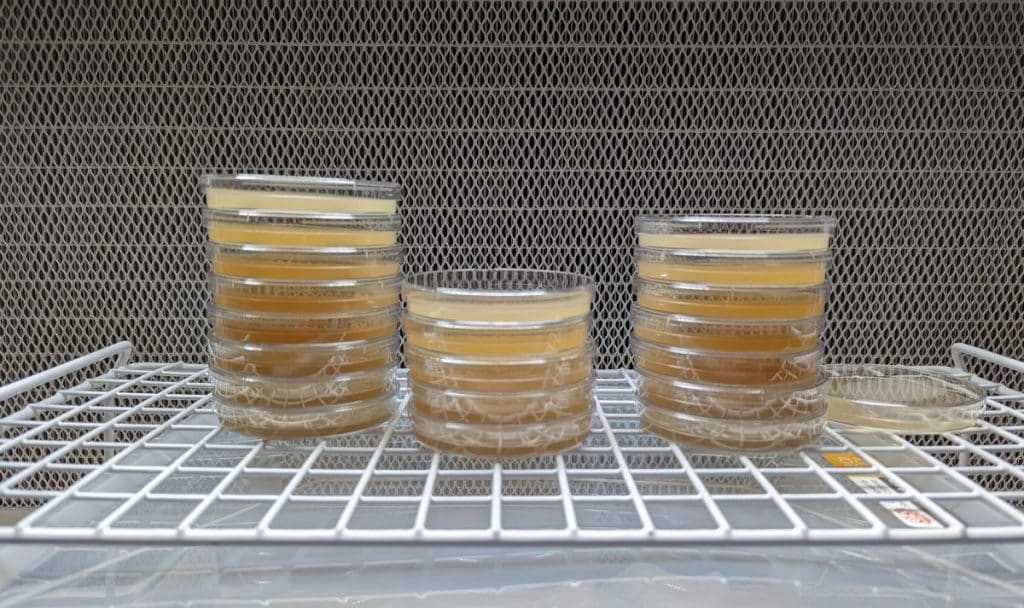
3. What Inoculation Rate to Use
The inoculation rate is the amount of mushroom spawn or liquid culture added to a substrate and is usually shown as a ratio to the amount of substrate.
What is the inoculation rate for mushroom spawn? Ideal inoculation rates balance colonization speed and cost of spawn per pound or kilogram of mushroom yield.
The higher the spawn rate, the faster the mycelium will colonize the substrate, but generally, you don’t get a higher yield.
Growers aim to use as little spawn as possible while not drastically increasing colonization time or chances of contamination.
Different substrates need different spawn rates, so you’ll have to do a little research before inoculating your substrate.
The type of mushroom you’re growing also affects the inoculation rate, and you may need to use more spawn when growing fussier species that are slow colonizers.
If beginner mushroom growers start with a higher spawn rate than is usual when growing a species for the first time, it increases their chances of success.
4. How You’re Going to Distribute the Spawn
Spawn distribution refers to how you mix or distribute your spawn in the substrate and is another factor affecting colonization speeds.
Popular distribution methods are top spawning, through spawning and layering, but there are others. For example, when growing mushrooms in bottles, machines insert spawn into a hole in the center of the substrate.
Top spawning involves adding spawn to the top of a substrate and letting it grow down through the substrate.
Although this method saves time because you do not need to mix the spawn into the substrate, colonization takes longer, increasing the chances of contamination.
When through spawning, you mix the spawn and the substrate until the spawn is evenly distributed throughout the substrate. This method generally results in shorter colonization times.
Layering is a form of through spawning and involves adding alternating layers of spawn and substrate. Layering is often used when growing mushrooms outdoors in beds.

What Can I Use for Mushroom Inoculation?
You can use a spore syringe, liquid culture or spawn to inoculate a growing medium.
Mushroom farmers commonly use mushroom spawn and liquid culture to inoculate substrates, as they usually contain mycelium cloned from a proven strain with desirable characteristics.
But growers sometimes use spore syringes, especially those who grow Psilocybin mushrooms, as their spores are often legal, but the mycelium is not.
Growing mushrooms from spores is less popular because when hyphae from two spores combine, they create a new strain, making it impossible to predict the mushrooms characteristics.
How Do You Make Mushroom Inoculant?
A mushroom inoculant is anything used to inoculate a growing medium, including a spore syringe, liquid or petri dish culture, or grain spawn.
There are two ways to grow mushrooms; using spores to create a new strain or cloning an existing strain, using a piece of mushroom.
Spores
To grow mushrooms from spores, you first have to collect mushroom spores. This is usually done by making a spore print on foil or a glass surface.
Our article, “How to Make a Mushroom Spore Print Step by Step,” takes you through this process in detail.
The mushroom spores are then scraped off the foil into a small container of sterile water in sterile conditions. The spore-filled water is then drawn up into a syringe.
Growers usually use spore syringes to grow mushroom cultures in petri dishes or inoculate sterilized grain to make grain spawn.

Cloning
You can use small pieces of mushroom tissue to grow mycelium in petri dishes with a nutritious medium like agar.
You can also grow mycelium from tissue in a nutrient solution.
Growers use the petri-dish or liquid culture to inoculate jars or bags of grain to create grain spawn.
Our step-by-step guide to cloning mushrooms shows you how to clone mushrooms using mushroom tissue on an agar plate.
But if you don’t have access to laboratory conditions, you can clone mushrooms and create spawn the low-tech way, using the stem butt method.
Our article,” How To Grow Your Own DIY Mushroom Spawn,” provides a step-by-step guide to creating spawn using oyster mushroom stems and damp cardboard.
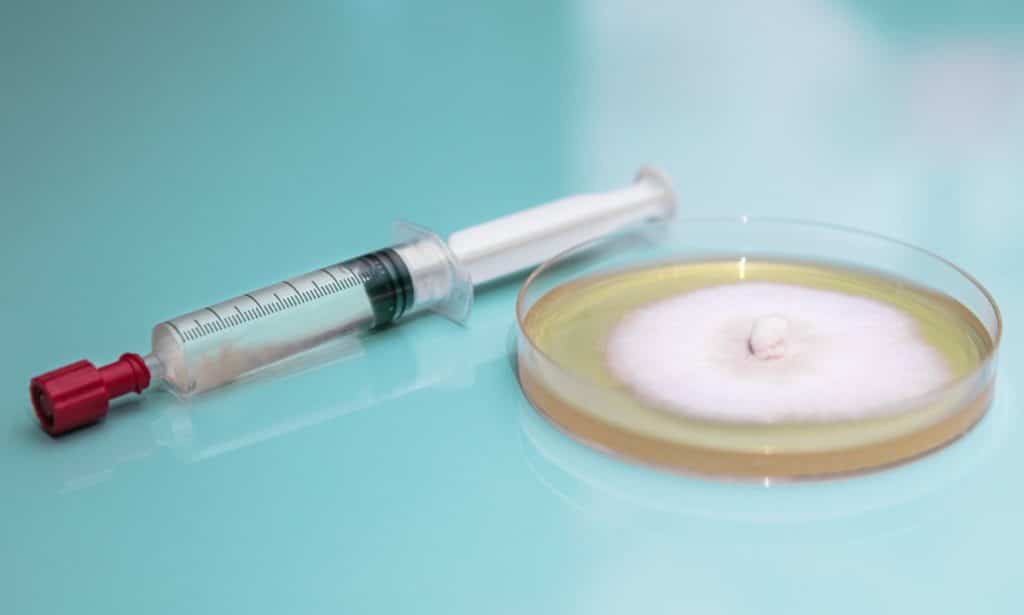
How Do You Inoculate Grain?
Mushroom cultivators use liquid or petri dish cultures containing living mushroom mycelium to inoculate grain.
How do you inoculate with mushroom culture? The process is straightforward but sterile conditions are crucial as grains are nutrient-rich and contaminate easily.
To inoculate grain, you’ll need the following:
- Liquid or petri dish mushroom culture
- Sterilized grain in a bag or jar with a filter lid
- A laminar flow hood, still air box, glove box or similar clean environment
- A scalpel if using petri-dish culture
- An alcohol burner or a steady flame source for sterilizing the blade or needle
- Gloves and rubbing alcohol
In sterile conditions, add mushroom culture by injecting liquid culture into the grain or inserting small pieces of petri-dish culture.
When the culture is in the grain jar or bag, shake the bag or jar to distribute the culture throughout the grain and leave it to colonize.

How to Inoculate Substrate
Mushroom cultivators growing mushrooms indoors often use grain spawn to inoculate mushroom substrates and fruit mushrooms.
Although sawdust spawn colonizes faster, grain spawn is easier to break apart and distribute through the substrate.
The mushroom species and type of substrate will dictate whether you need to inoculate your substrate in sterile conditions.
Some growers add grain spawn directly to bags of substrate and mix them together in the mushroom growing bag.
This works if you’re inoculating small quantities of a substrate, but for larger quantities, we like to mix the spawn into the substrate in a tote or bucket before adding it to the bags.
This allows you to mix the spawn and substrate well, ensuring an even distribution throughout the substrate.
If you’re working with nutrient-rich or supplemented substrates, you’ll need to inoculate them in sterile conditions.
You’ll find more information on inoculating substrates in our article,” How To Grow Mushrooms on Straw: A Step by Step Guide,” and our “Complete Guide to Growing Mushrooms on Sawdust Blocks.”
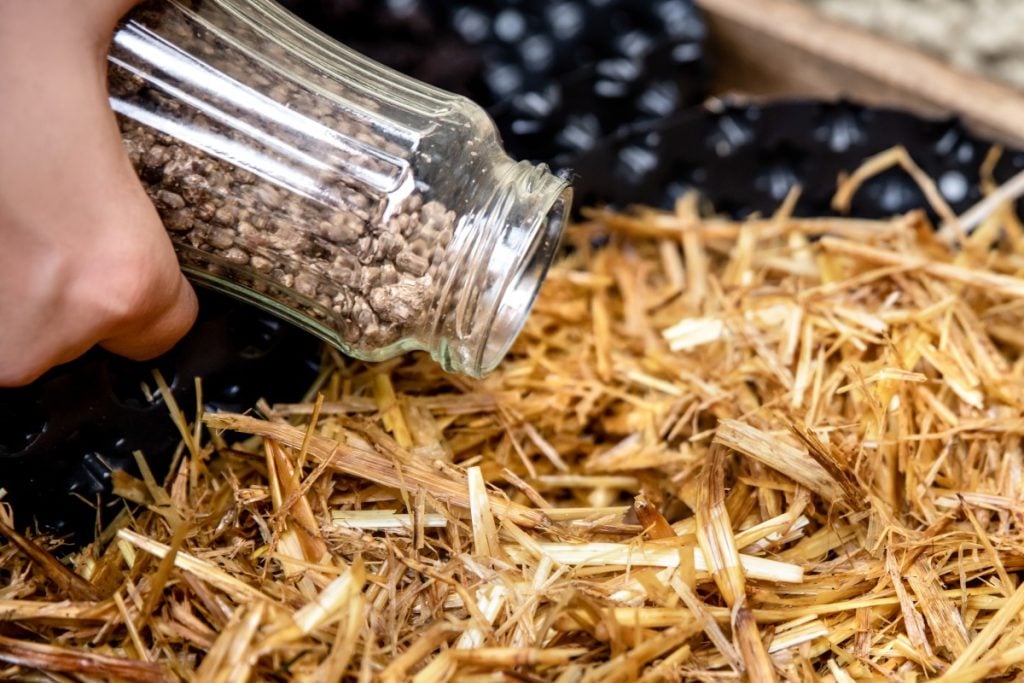
How to Inoculate Logs
Growers commonly use plug spawn or bulk sawdust spawn as inoculants when growing mushrooms outdoors on logs.
There are two log inoculation methods, the traditional and the totem method.
The traditional method involves drilling holes in your logs, filling the holes with plug or sawdust spawn and sealing them with wax.
Plug spawn is easy to use and great for beginners or people inoculating a few logs who don’t want to invest in equipment.
But it’s worth buying the tools for larger jobs, as sawdust spawn is more efficient and colonizes 30% faster than plug spawn.
The totem or pillar method consists of three pieces of 10 – 12 inch (20 – 30 cm) diameter logs stacked upright with sawdust spawn sandwiched between them.
Our article, “How To Grow Mushrooms On Logs: The Ultimate Guide,” has a step-by-step guide on inoculating logs using the traditional method.
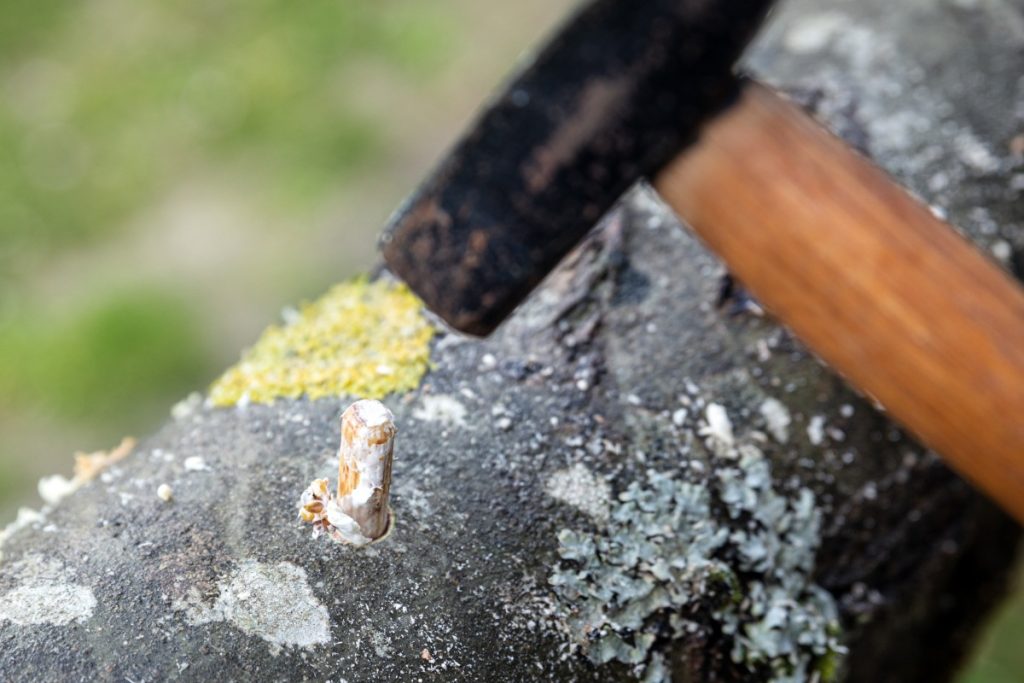
How to Inoculate Mushroom Beds
When growing mushrooms outdoors in mushroom beds, growers generally recommend using sawdust spawn as birds often enjoy eating grain spawn.
Layering is the most common distribution method used when growing mushrooms in beds.
In the video below, you can see this in practice.
Here we use the layering method to inoculate a bed of wood chips with wine cap mushroom spawn and six months later harvested our first fresh wine caps.
Important Factors for Successful Inoculation
Growing mushrooms is extremely rewarding, and watching as the mycelium colonizes the substrate is fascinating for first-time mushroom growers.
But for inoculation and colonization to be successful, there are some important factors to remember, including:
- Always use high-quality spawn or culture purchased from a reputable supplier.
- Use a substrate that’s suitable for the mushroom species you’re growing.
- Make sure the substrate is correctly hydrated and pasteurized or sterilized.
- Use a clean area to inoculate a substrate. This is most important for nutrient-rich substrates that contaminate easily. But less important for carbon-rich/low nitrogen substrates like logs or pasteurized straw that you can inoculate outside in a non-clean area.
- Check the substrate temperature. If you’ve sterilized your substrate, ensure it’s cooled to room temperature so you don’t kill the mycelium.
- Use a spawn rate that matches the cultivation method you’ve chosen (You can use a low spawn rate of 1 to 3% if the substrate is fully sterile, but a higher rate of 5 to 20% is needed when using non-sterile substrates)
Common Issues with Inoculation and How to Prevent Them
As with any new skill, learning to grow mushrooms takes practice, and knowing how to avoid common mistakes helps with successful inoculation.
Contamination
Mushroom contamination is the most common problem experienced by mushroom growers of all levels, and several factors could be the cause, including:
- Improper substrate preparation – If your substrate is not pasteurized or sterilized correctly, it increases the chances of contamination.
To avoid this, ensure your substrate reaches the desired temperatures for the correct duration for sterilization or hot pasteurization.
If you’re using one of the cold pasteurization techniques, ensure your solution is correct, and completely submerge the substrate for the required time. - Poor quality spawn – Always buy spawn from a reputable supplier. Poor quality or old spawn may grow slowly, increasing the chances of contamination.
- Non-clean inoculation procedure – It’s best to inoculate nutritious substrates in sterile conditions in front of a laminar flow hood.
And even when inoculating less-nutritious substrates, you’ll need to ensure that your work surface, hands and tools are as clean as possible.
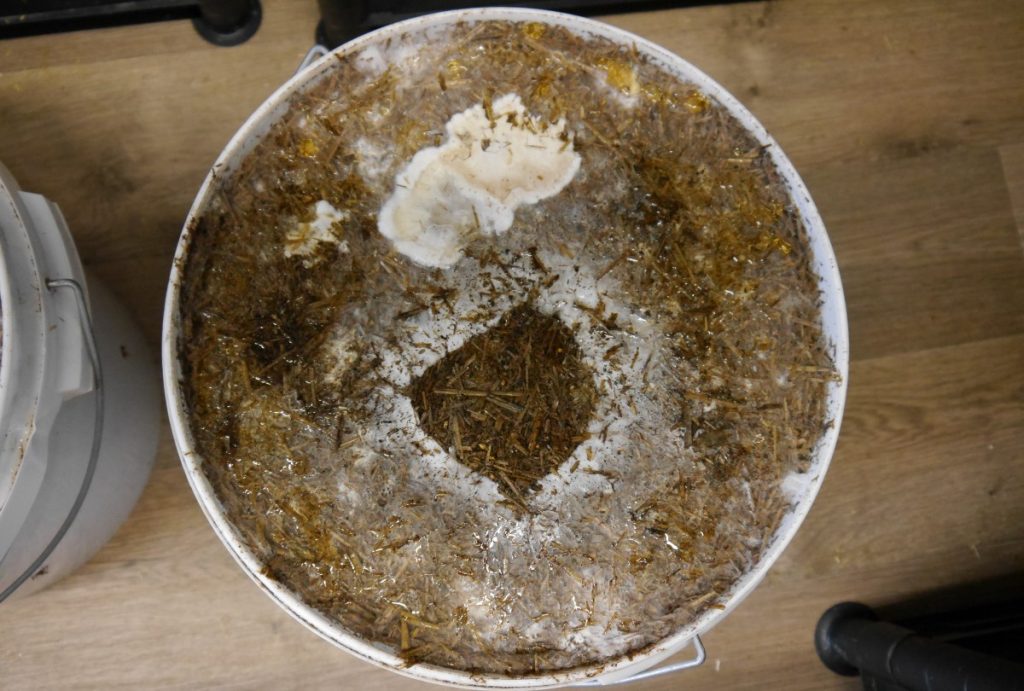
Slow Mycelial Growth
Another common problem is slow-growing mycelium that either does not grow at all, takes a long time to colonize the substrate or fails to completely colonize a substrate.
Several factors may cause this, including:
- Poor quality spawn – Spawn becomes less viable the longer you store it. Inferior strains or old spawn can cause smaller yields, slow growth or no growth. If possible, buy spawn from a reputable supplier nearby, so the spawn doesn’t have to travel long distances and use it as soon as possible.
- Low incubation temperature – Temperatures below the optimum range for a mushroom species often result in longer colonization times.
To prevent this, research the ideal incubation conditions for the species and try to provide these. If you live in an area that’s very cold, you may need to incubate your substrate in a temperature-controlled room or fruiting chamber.
- Poor air exchange – Like us, mycelium needs oxygen to survive and grow, and although it can tolerate higher levels of CO2 during incubation, it needs some fresh air exchange to grow properly.
Ensure your growing container or bag has filter patches or holes covered with micropore tape to allow fresh air exchange without drying out the substrate.
- A substrate that’s too dense – Substrates with fine particles can become compacted, preventing fresh air exchange. If you’re using a substrate with fine particles like coffee grounds and want to grow mushrooms in large bags or buckets, adding 20 – 50 percent pasteurized straw helps to ensure good airflow.

Final Thoughts
There is more than one way to inoculate substrates and grow mushrooms, and it can be tempting for beginners to want to jump in and learn everything at once.
But this is not something we recommend. Not doing everything yourself and starting small are two lessons we learned the hard way. Our article, “5 Things I Wish I Knew Before I Started Growing Mushrooms For A Living,” covers these and other valuable lessons.
If you’re a beginner, we recommend starting with mushroom grow kits or ready-to-fruit substrate blocks, and only moving on to the next step once you’ve successfully initiated fruiting and grown mushrooms.
The next step would be buying spawn of an easy-to-grow species like oyster mushrooms and preparing and inoculating a substrate. After this, if you wish to, you can try buying culture and inoculating grain to make grain spawn.
Cloning or growing mushrooms from spores to create your own culture is a great way to learn more about the mushroom life cycle and grow unusual species, but it takes time and requires sterile conditions. Many small-scale growers choose not to go this far.
To learn how to grow mushrooms using simple methods and minimal equipment, visit our Mushroom Growing Hub or try one of our mushroom cultivation courses.
